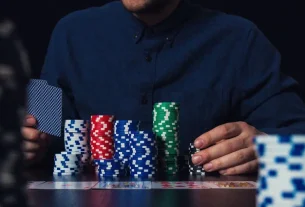Bluffing in poker is an art that requires careful study of its dynamics, adaptation and recognition of when an opponent may be vulnerable or an interesting story arises on the board. Furthermore, consistent bet sizing should also be employed.
Keep your emotions under control when your bluff fails, and avoid playing recklessly afterward to prevent making costly errors.
Game of chance
Bluffing is one of the key skills a poker player needs. While it may be easy to wait for a good hand and hope that opponents fold, making a successful bluff takes skillful strategy. This guide will teach you all of the strategies, tips and techniques necessary to maximize expected value (EV) from this key component of the game.
Your table image plays a critical role in your success as a bluffer. If your bets are perceived to represent strength, your bluffs are more likely to work effectively and your success rates as an ace bluffer may increase accordingly.
Attention should also be paid to body language as this can give away your tells. Adrenaline can lead to physical tells like jitters, dilated pupils and the pulsing of neck veins; professional players sometimes wear scarves to mask these signals. Timing bluffing attempts correctly is also key; making a bold claim when your opponents already possess strong hands will rarely lead to success.
Game of psychology
Mastering gambling psychology is integral to poker success, as it allows players to subtly alter the perceptions and expectations of opponents through showing confidence while keeping an eye on emotional processes at play.
Bluffing should be balanced with value betting, but it is also vital that you understand when and how often to bluff during a given game. This depends on factors like table image, hand strength and the size of bets placed.
Consider your opponent’s history when bluffing. For instance, if they have recently been caught bluffing it may be wiser for them to reduce bluffing frequency in favor of value betting more often. Also keep an eye on their mental state after being picked off on a bluff as this may prompt riskier decisions from them.
Game of skill
Bluffing is an essential element of gaming and can be immensely profitable; however, it requires an in-depth knowledge of both your opponents and game situation to succeed at bluffing successfully. External factors or events could impact their decision making skills while body language also gives away intentions.
As with any bet size decision, choosing your bluffing bet sizes carefully is equally essential. A skilled player will determine its profitability by balancing potential hand value against risk associated with bet size – for instance when facing off against an opponent on a K 7 2 board it would be prudent not to check back early with value hands as these might lose showdown value by river stage – so understanding opponent preflop tendencies is key here.
Game of intuition
Poker’s intuition can be an incredibly useful asset to help guide decision-making, but experts caution against over relying on intuition alone; to balance intuition with logic. Trusting instinct takes experience and practice – an asset worth cultivating during every hand of poker play!
Bluffing is an integral component of poker, yet it can be difficult to identify whether or not your opponents are bluffing. Even experienced bluffers will occasionally make mistakes that cost them dearly; to stay competitive it is key that any failed bluff be handled promptly in order to prevent tilt.
One’s bluffing decisions may depend on various factors, including risk-taking tendencies, self-confidence and the context of the game. Emotions also play a factor; especially after making poor calls. Therefore, it is crucial that emotions remain under control so you can make sound strategic decisions in future.





